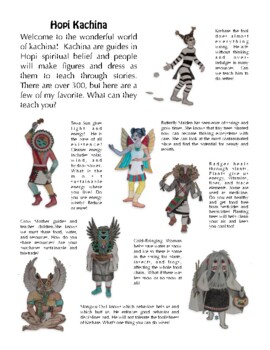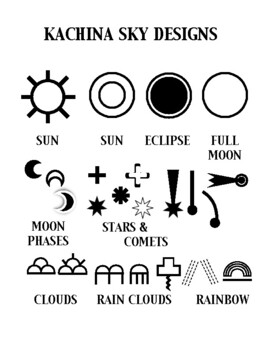Kachina Craft
15 Minute Field Trips
19 Followers
Grade Levels
1st - 4th, Homeschool
Subjects
Resource Type
Standards
CCSSCCRA.L.4
CCSSCCRA.L.6
NGSS1-ESS1-1
NGSSK-ESS2-1
NGSS3-ESS2-1
Formats Included
- PDF
15 Minute Field Trips
19 Followers
Description
Make countless crafts based on Hopi kachina spirit guides and your imagination! Great for ages 7 and up, or younger with adult help. A great family activity!
Total Pages
Answer Key
N/A
Teaching Duration
N/A
Report this resource to TPT
Reported resources will be reviewed by our team. Report this resource to let us know if this resource violates TPT’s content guidelines.
Standards
to see state-specific standards (only available in the US).
CCSSCCRA.L.4
Determine or clarify the meaning of unknown and multiple-meaning words and phrases by using context clues, analyzing meaningful word parts, and consulting general and specialized reference materials, as appropriate.
CCSSCCRA.L.6
Acquire and use accurately a range of general academic and domain-specific words and phrases sufficient for reading, writing, speaking, and listening at the college and career readiness level; demonstrate independence in gathering vocabulary knowledge when encountering an unknown term important to comprehension or expression.
NGSS1-ESS1-1
Use observations of the sun, moon, and stars to describe patterns that can be predicted. Examples of patterns could include that the sun and moon appear to rise in one part of the sky, move across the sky, and set; and stars other than our sun are visible at night but not during the day. Assessment of star patterns is limited to stars being seen at night and not during the day.
NGSSK-ESS2-1
Use and share observations of local weather conditions to describe patterns over time. Examples of qualitative observations could include descriptions of the weather (such as sunny, cloudy, rainy, and warm); examples of quantitative observations could include numbers of sunny, windy, and rainy days in a month. Examples of patterns could include that it is usually cooler in the morning than in the afternoon and the number of sunny days versus cloudy days in different months. Assessment of quantitative observations limited to whole numbers and relative measures such as warmer/cooler.
NGSS3-ESS2-1
Represent data in tables and graphical displays to describe typical weather conditions expected during a particular season. Examples of data could include average temperature, precipitation, and wind direction. Assessment of graphical displays is limited to pictographs and bar graphs. Assessment does not include climate change.





